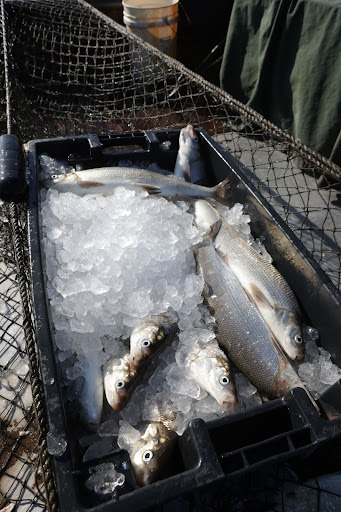What does it take to be a Great Lakes commercial fishing deckhand or seafood processor?
Sea Grant team identifies skills, training to learn to be successful in the commercial fishing industry.

The future of the Great Lakes commercial fishing industry depends on recruiting and retaining the next generation of commercial fishers and fish processors. Commercial fisheries and fish processors are a vibrant part of Great Lakes heritage and legacy, and continue to be important to the regional economy. They benefit the U.S. food system, human health, and the economic and social wellbeing of the coastal communities where they operate and beyond.
Michigan Sea Grant and Wisconsin Sea Grant partnered on a project funded by the National Sea Grant Office to develop a framework for a commercial fisheries and fish processing training program. This joint project has strategically placed the seafood industry and partners in a position to capitalize on the Young Fishermen’s Development Act funding. Congress has authorized $2M in funding per year beginning in 2022 for the act.

The goal of this project was to design a framework that can be used to implement a Great Lakes commercial fishing and fish processing apprenticeship program. This project explored existing frameworks in other regions, and was grounded in the perspectives of commercial fishers, seafood processors, and regulators in the Great Lakes region to inform a place-based apprenticeship program. We surveyed commercial fishers and seafood processors in the Great Lakes region (48 participated), as well as hosted five semi-structured focus groups with various state and tribal fishers and processors. The focus groups were used to validate the trends found in the survey. Using these findings, we propose the following framework for a Great Lakes Commercial Fishing/Seafood Processing framework.
Apprenticeship framework
Because the Great Lakes fisheries are managed within an overlapping complexity of state and tribal boundaries, licensing limits, quotas, species, and gear types, we decided a single approach would not be appropriate for all commercial fishers and processors in the Great Lakes region. Instead, we have put together a menu of options for a training program that we would use to work in different areas to offer based on the culture and location for a new Fisheries 101 fundamentals program. Following are the content areas that were elicited in our assessments:
Options for Deckhand or Processing
Deckhand
- Fishing gear types and techniques (by species)
- Gear repair (mechanical repairs, net mending)
- Navigating and boating (Captains license)
- Coast Guard Drill Instructor Training
- Knot and knives
- Safety with environmental working conditions (weather)
- Quality control points program (for on the boat)
- Fishing regulations
- Fish population/stocks/management
- Communicating value of the industry
Processing
- Knife handling
- Safety with manual and automated equipment
- Food regulations
- Seafood HACCP Training
- Sanitation Control Procedures Training
- Marketing/economics (supply and demand)
- Resources for product development
- Communicating value of the industry
Optional general content
- History of the industry
- Setting expectations
- Working and communicating across generations
- Communicating value of the industry to … (regulators, consumers, legislators, etc)
- Stress/mental health awareness
- Marketing/economics/business planning (successful models)
- Culinary products/education
- Supply and demand impacts
- Business management: Break even costs
- Time management
- Ergonomics
- CPR/First Aid Training
- Regulation software
- Cross-training/certifications/Career pathways and access points
- History of population dynamics until now, to the future (is there a sustainable yield?)
- Workforce recruitment and retention strategies
Approaches:
- Find common ground and values
- Business roles and employee expectations
- Economies of scale
- Flexibility and assessments (when do you know if it’s working? Or not?)
- Market diversification
- Vertical integration
Michigan Sea Grant and Wisconsin Sea Grant are continuing to work with the industry to plan pilot projects using this framework to implement the Great Lakes Future Fisheries Initiative Program.
Local seafood
Do you want to find local seafood? You can find local fish products near you by visiting FreshFishFinder.org.
Michigan Sea Grant helps to foster economic growth and protect Michigan’s coastal, Great Lakes resources through education, research, and outreach. A collaborative effort of the University of Michigan and Michigan State University and its MSU Extension, Michigan Sea Grant is part of the NOAA-National Sea Grant network of 34 university-based programs.
This information was prepared by Extension educator Dr. Lauren N. Jescovitch under award NA18OAR4170097 (IRB STUDY00006120) from the National Oceanic and Atmospheric Administration, U.S. Department of Commerce through the Regents of the University of Michigan. The statements, findings, conclusions, and recommendations are those of the author(s) and do not necessarily reflect the views of the National Oceanic and Atmospheric Administration, the Department of Commerce, or the Regents of the University of Michigan.



 Print
Print Email
Email



